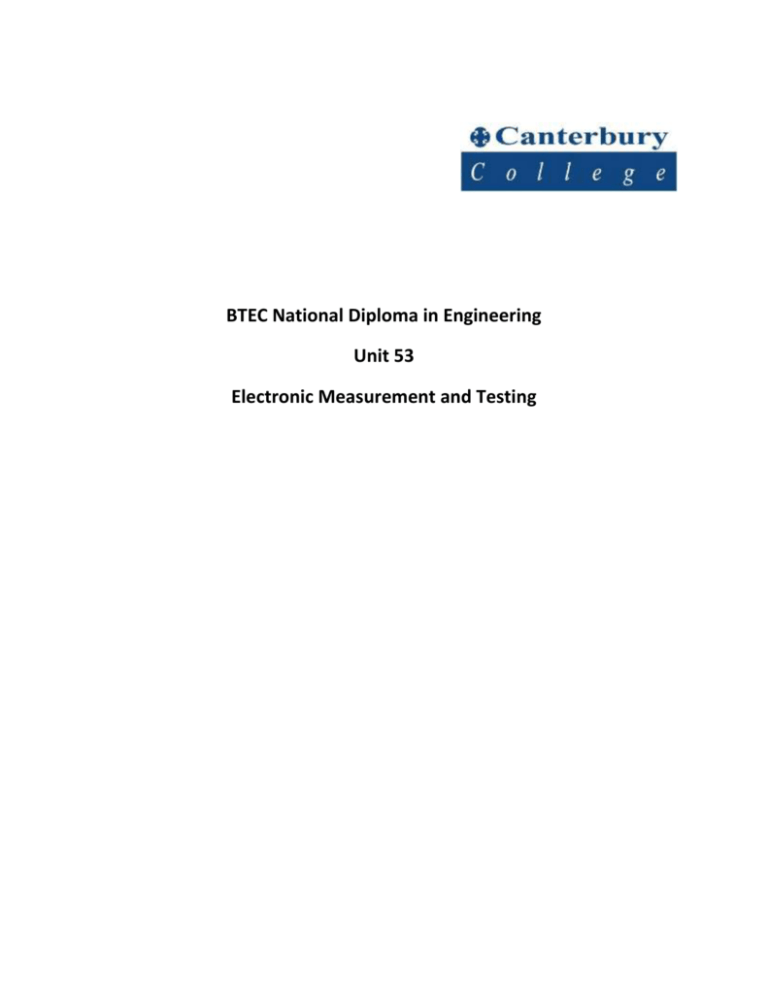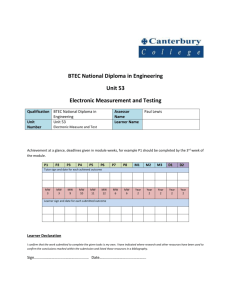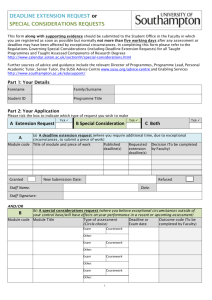BTEC National Diploma in Engineering Unit 53 Electronic
advertisement

BTEC National Diploma in Engineering Unit 53 Electronic Measurement and Testing Unit Name and Number Student Assessor Task book issue date Completion date (pass outcomes) Learner Signature The following grid gives details of the submission and referral deadlines for each of the pass outcomes listed. The deadline for each outcome will be indicated in the same box as the outcome criteria. Outcomes included in this task book Tasks are ordered in accordance with the outcomes listed P1 Describe the function, features and characteristics of a measurement instrument Deadline: Module Week 4 P2 Describe the function, features and characteristics of three different pieces of electronic test equipment Deadline: Module Week 4 P3 Use test equipment and measuring techniques to take measurements from three different pieces of electronic equipment Deadline: Module Week 6 P4 Explain the importance of test specifications as an aid to ensuring the validity and consistency of measurements Submitted Achieved? Referred Re-submitted (Date) (Sign and date) (Resubmit by?) (Date) Deadline: Module Week 7 P5 Describe the principles and need for calibration of an item of electronic test equipment Deadline: Module Week 8 P6 Describe the health, safety and configuration issues that need to be considered when connecting test equipment to an item of electronic equipment that needs testing Deadline: Covered in induction P7 Use a virtual measurement and testing system to carry out a test on a piece of electronic equipment Deadline: Module Week 10 P8 Describe the measurement techniques, instrument connection, hardware and software used. Deadline: Module Week 10 M1 Explain the importance of resolution, accuracy, sensitivity bandwidth and input impedance on the performance of a piece of test equipment Deadline: By the end of the module M2 Use a manufacturer’s recommended procedure together with laboratory instruments and standards to calibrate and configure an item of electronic test equipment Deadline: By the end of the module M3 Use appropriate software to display and analyse voltage/time date captured from a virtual oscilloscope Deadline: By the end of the module D1 Evaluate the accuracy of own test measurements and relate them to limitations of the test equipment, test procedures or possible emerging fault conditions Deadline: By the end of the module D2 Devise and demonstrate a calibration procedure for an item of electronic test equipment Deadline: By the end of the module Learner Declaration I confirm that the work submitted to complete the given tasks is my own. I have indicated where research and other resources have been used to confirm the conclusions reached within the submission and listed those resources in a bibliography Sign and date for each task P1 P2 P3 P4 P5 P6 P7 P8 P9 P10 P11 M1 M2 M3 D1 D2 Task 1 (P1) Check the following Tick to confirm you have fulfilled the requirements for this outcome Have you included documentary evidence such as a drawing, illustration or photograph which you can label and indicate the function of the various buttons and dials? Have you fully described the features of an oscilloscope e.g. its input and output connectors? Have you described the importance of the characteristics of an oscilloscope such as its input and output impedance, bandwidth and accuracy? Task 1. Describe the function, features and characteristics of an oscilloscope. Task 2 (P2) Check the following Tick to confirm you have fulfilled the requirements for this outcome Have you included documentary evidence such as a drawing, illustration or photograph which you can label and indicate the function of the various buttons and dials? Have you fully described the features of test equipment such as function generators e.g. such as its portability or in built calibration facilities Have you described the importance of the characteristics of test equipment such as its input and output impedance, bandwidth and accuracy? Tasks Describe the function, features and characteristics of the following three pieces of electronic test equipment. 1. A function generator 2. A power supply 3. A logic probe Task 3 P3 Use test equipment and measuring techniques to take measurements from three different pieces of electronic equipment. Check the following Tick to confirm you have fulfilled the requirements for this outcome Make sure that you make use of the guidance and carry out the practice tasks in the module task book. You should make full use of documentary evidence to illustrate your submission. Use photographs, drawings and schematics where appropriate. When finding out the internal impedance of a power supply you will need to use Ohm’s law at some stage. Make sure you show all of your calculations neatly with answers double underlined. Introduce each stage of the given tasks to the reader. This will both help to inform the reader and give a sense of organization to the submission. As always, briefly evaluate your findings. Select test equipment and use measurement techniques to carry out the following tasks: 1. Investigate the frequency range of the laboratory function generator which is set up to give a square wave output using appropriate test equipment. Approximately at what frequency does noticeable distortion of the waveform occur and how does this relate to the bandwidth of the oscilloscope? 2. Determine the approximate internal resistance of the laboratory power supplies using appropriate test equipment. 3. Measure the input and output waveforms to the LM386 power amplifier and determine magnitude and nature (leading or lagging) of the phase shift incurred by the circuit. 4. Measure and record the output of the 4 stages of the 74LS93 counter in the given traffic light circuit. Find the rise time of the signal and relate this to the bandwidth of the oscilloscope. Task 4 (P4) Explain the importance of test specifications as an aid to ensuring the validity and consistency of measurements. Check the following Tick to confirm you have fulfilled the requirements for this outcome Have you defined validity and consistency with respect to test measurements explaining why both are important parameters when we are taking measurements? Have you explained what a test specification is? For example, if you were going to buy a car that could accelerate from 0 – 60 mph in 10 seconds. How could you be sure that the information given on the cars performance is accurate and reliable? 1. To complete this task you can either give a written or verbal presentation using one of the tasks carried out for P3. If you choose to give a verbal presentation then you will need to arrange a suitable time and place with your tutor. Task 5 (P5) Describe the principles and need for the calibration of an item of electronic test equipment. Check the following Tick to confirm you have fulfilled the requirements for this outcome Have you described the need for and importance of Standards organizations? Have you briefly described the various types of standard and how they are applied (International, National Primary, Secondary, Working and Time/Frequency standards). Have you briefly described the principles of measurement and the need to be able to compare measurements with a recognized quantity or reference (standard). Have you explained why it is important to regularly calibrate electronic test and measurement equipment? Finally what does the calibration of an electronic measurement instrument help to ensure? 1. Once again this task could be combined as a written or verbal presentation with P5 using one of the tasks from P3 as a basis for your presentation. Task 6 (P6) Describe the health, safety and configuration issues that need to be considered when connecting test equipment to an item of electronic equipment that needs testing. Check the following Tick to confirm you have fulfilled the requirements for this outcome Have you considered the precautions that need to observed before measuring mains level voltages (>240 volts)? What precautions should be observed when working with batteries (replacing, charging and disposing)? In the case where you are required to replace items of electrical equipment which will necessitate handling components: Have you described the procedures for ensuring the electrical equipment is isolated before work begins and remains isolated for the duration of the work? Have you described the precautions that must be observed when adjusting ‘live’ equipment? Have you described the importance of earth bonding of electrical equipment, and checking the continuity of the earth bonding of electrical equipment? Have you briefly described the use and availability of electrical safety equipment such as safety cut outs, fuses, residual current devices (RCD) and earth circuit leakage breakers (ELCB) 1. You are required to present a written submission outlining the precautions to be taken when working with electrical and electronic equipment. Make sure you fully cover all of areas listed in the table above. Task 7 (P7 & P8) P7 Use a virtual measurement and test system to carry out a test on piece of electronic equipment. P8 Describe the measurement techniques, instrument connection, hardware and software used. Check the following Tick to confirm you have fulfilled the requirements for this outcome Have you described the type of virtual oscilloscope used to carry out this task? Have you listed the system requirements needed to run this virtual measurement and test system (processor speed, bandwidth, ram, operating system, bus capability) Have you provided screen dumps showing how you set up the virtual scope to capture data from the test? Have you described or demonstrated how data can be stored from the test? 1. You can reproduce either task 1, 3 or 4 from P3 to complete this outcome. Make sure you have covered the points in the table. Task 8 (M1) 1. Explain the importance of resolution, accuracy, sensitivity bandwidth and input impedance on the performance of an oscilloscope. You can use any of the tests in the pass section (which required and oscilloscope) as a basis for your submission, especially the tasks carried out for P3. Task 9 (M2) Use a manufacturer’s recommended procedure together with laboratory instruments and standards to calibrate and configure and item of electronic test equipment. 1. Use the manufacturer’s recommended procedure to calibrate and configure a laboratory oscilloscope. 2. Use the calibrated scope to check the accuracy of a laboratory function generator with respect to frequency and amplitude. 3. Check the accuracy of your measurements against that given by the manufacturer of the function generator. 4. Based on your findings, would you recommend that the function generator needs to be sent back to the manufacturer for calibration? You need to justify this recommendation. Task 10 (M3) Use appropriate software to display and analyse voltage/time data captured from a virtual oscilloscope. 1. This is a natural extension of the task given for P7. In this case you are required to analyse a waveform. The best way to accomplish this given the limitations of the software is to show the frequency spectrum of a square waveform and note the harmonics present. 2. Compare the frequency spectrum of the square waveform with that of a ‘pure’ sine wave. Evaluate your findings. Task 11 (D1) Evaluate the accuracy of your own test measurements and relate them to limitations of the test equipment, test procedures or possible emergent fault conditions. 1. You can use any of the tests carried out in the various exercises or practical projects as a basis for this evaluation. The submission needs to be an ‘in-depth’ investigation of the effects of connecting test/measurement equipment to a circuit under test and how the results are limited by the characteristics of the test equipment and procedures. 2. As an example an oscilloscope is incapable of accurately displaying a transient pulse due to its finite bandwidth. This could be the basis of an investigation carried out by you to explain why? Task 12 (D1) 1. Devise and demonstrate a calibration procedure for a x10 oscilloscope probe to be used with the laboratory oscilloscopes. Explain why the probe needs to be calibrated and under what circumstances such a probe might be required in preference to a standard x1 probe.






